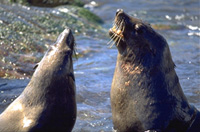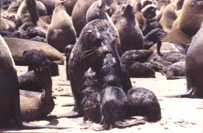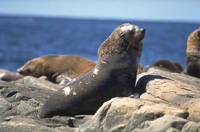South African and
Australian Fur Seals
(Arctocephalus pusillus)
IUCN STATUS (2010) - LEAST CONCERN
| Distribution and Numbers There are two subspecies of this fur seal - the South African or Cape fur seal (Arctocephalus pusillus pusillus) and the Australian fur seal (A. pusillus doriferus). The Australian fur seal population is believed to be derived from the South African fur seal population. South African fur seal: The South African fur seal is found along the coast of Namibia and the west and south coasts of South Africa. Breeding colonies stretch from Cape Frio in Namibia, close to the Angolan border, to Black Rocks, near Port Elizabeth in South Africa. The population size is estimated to be 1.5-2 million, about two thirds of which are in Namibia. |
 A.p. doriferus Photo: Liz Poon, CSIRO Wildlife and Ecology |
| Australian fur seal: Breeding colonies for the Australian fur seal are restricted to nine islands in Victoria and Tasmania, all in Bass Strait, and there is a total population estimate of 30,000-50,000. The largest colony is at Seal Rocks in Victoria. The non-breeding range of the Australian fur seal extends from Kangaroo Island in South Australia to Tasmania and Port Macquarie in New South Wales. |
| Status Both subspecies are listed on Appendix II of the CITES Convention. |
| South African fur seal: Commercial killing of South African fur seals has continued in some form since the early 1600s and more than 2.7 million South African fur seals have been killed since 1900, mostly in Namibia. In the 1980s the demand for the bulls' genitals by the Far Eastern aphrodisiac trade meant that only the genitals of many of the killed seals were taken. An unknown, but relatively small, number of fur seals are victims of marine pollution. |
| (Namibia): There is an annual commercial hunt of South African fur seals in Namibia which takes place between August and November. The hunt quota for the 2000 season was set at 60,000 pups and 7,000 adult males, almost double that of the 1999 quota of 30,000 pups and 5,000 adult males. The number of hunt concession holders for the 2000 season was also doubled from two to four. The Namibian government has claimed that the increased hunt is needed to protect fisheries, a claim countered by environmental groups who point out that no scientific evidence has been shown to indicate that an increased seal hunt would actually benefit Namibian fisheries. Environmental groups are also opposing the hunt on grounds such as welfare, sustainability and economics. The pups are normally clubbed to death and the adult males are shot. Photographers are banned from the beaches where the hunt is taking place and one conservation organisation has complained that it has been unable to monitor the hunt because of bureaucratic obstacles. |
| Conservation organisations severely criticised the hunt as cruel, unlawful and uncontrolled after secretly-filmed footage was shown on South African television in October 2000. One organisation said that the footage confirmed that regulations regarding the killing of seals were not being adhered to due to insufficient supervision of the hunters, commenting that the television footage showed groups of hunters indiscriminately lashing out at seals in a frenzied manner and without the use of the obligatory "stickers" (used to stab seal pups in the heart after they have been clubbed to ensure immediate death). Later in the same month, students in Swakopmund carrying out field studies came across a number of young seals either dead on the beach or swimming lamely in shallow waters. A resultant survey of a 20km stretch of beach found 50 dead seals, 42 of which had non-natural injuries to the head, the rest of which were too decomposed to identify probable cause of death. |
| There are currently plans to build a factory complex at Henties Bay which will act as an abattoir, bone meal plant, fat processing plant (with laboratories for the bottling and manufacturing of oils, capsules, creams and cosmetics), tannery, shoe factory, leatherware factory, canning factory, research laboratory, museum and retail sales outlet. It is believed that the sale of seal genitalia for the aphrodisiac trade in the Far East is the most lucrative part of the industry. The companies planning the complex were reported, before the 2000 quota was announced, as seeking an increase in the number of seals killed each year. At the beginning of 2000 the Namibian government called on its people, who have traditionally shunned eating seal products, to "develop a taste for seal meat". |
| An estimated 150,000 new born pups, virtually all of the pups born, unexpectedly died each year on the Namibian coast in 1994 and 1995. Tens of thousands of adult fur seals also died during these two years. This mortality was almost certainly due to malnutrition and starvation because of a scarcity of fish caused by environmental conditions. A warning was issued in January 2001 that a similar situation could re-occur and that up to three quarters, 150,000, of the total number of fur seal pups in Namibia could starve if weather conditions continued to push the fish they eat away from the shore. |
| (South Africa): The hunt in South Africa has been suspended since 1990 by Government decree. Fur seals in South Africa have been protected since 1893, the most recent legislation being the Sea Birds and Seals Protection Act of 1973 which affords complete protection but allows the government to grant permits to kill fur seals at specific colonies. Between 1973 and 1982 there were an average of 18,750 pups and 530 adult males killed per year, and from 1983 until the suspension the average was 3,500 pups and 4,300 adult males, although these figures were highly variable between years. A small number of subadult male fur seals were culled around the island of Malgas in March 1999 and again in February 2000 in order to protect Cape gannet fledglings on the island from seal predation. |
| There are numerous interactions between South African fur seals and line, trawl and purse-seine fisheries, seals being accused of taking fish from the nets and lines or chasing the fish away. Many seals drown in the fishery nets and discarded fishing gear, or get caught in fishing boat propellers. Fishermen also claim that culling South African fur seals will increase fish stocks. Mathematical modelling studies have shown however that this is not necessarily the case due to the complexity of the marine food web, and that a seal cull might actually cause a reduction, for example, in the commercial catch of hake. |
| Australian fur seal: It is estimated that 200,000 Australian fur seals were killed for their fur in the 18th - 19th centuries. Restricted sealing continued in Tasmanian waters until as recently as 1970, but the fur seals are now protected by state law in both Victoria and Tasmania and, since 1975, by national legislation. Conflicts with fisheries still pose a great threat however, and there are concerns that these will increase as the population recovers. Australian fur seals are attracted to fish in static and, less commonly, trawl fishing nets and many are drowned in nets and traps or shot by fishermen and fish farmers. Fishermen in Victoria also claim that fur seals are drastically reducing commercial fish stocks but this is not substantiated by scientific evidence. Increased disturbance and increased pollution of Australian fur seal habitat with pesticides and heavy metals are additional threats to the population. |
| The attraction of mainly subadult and adult male fur seals to fish farms in southern Tasmania has caused particular problems. In October 2000 it was revealed that, despite their protected status, the Tasmanian government is to allow the killing of Australian fur seals that are deemed to be a hazard to fish farms and commercial fishermen. The decision came after strong pressure from the fishing community following events in which increasingly bold male fur seals are said to have been aggressive towards fishermen and fish farmers. A new "three strikes" protocol will result in offending fur seals being tagged and transported to waters on the other side of the island but euthanased by a vet if caught twice more. |
| A commercial fisherman in New South Wales applied for a licence in January 2000 to shoot Australian fur seals and New Zealand fur seals sharing his fishing grounds around Montague Island. Officials said however that there was very little chance of the licence being granted due to the seals' worth to the local economy through ecotourism, the ineffectiveness of such killing and the danger to the public of any shooting. In December 1998 authorities investigated the killing of at least 16 decapitated Australian fur seals, mostly pups, found on King Island in Bass Strait, and a further 6 dead fur seals found on Tasmanian beaches, some of which were decapitated. A local police source said that they believed that the number of seals found was only a fraction of those killed, and that someone had gone ashore at the nearby Reid Rocks colony, which was in the midst of its pupping season, and shot the seals before decapitating them. |
| It was revealed in June 2000 that the Australian federal government was to allow two ships trawling for blue grenadier in western Bass Strait off Tasmania to kill up to 30 Australian fur seals and New Zealand fur seals each in their nets during the forthcoming season, a measure taken in response to the two ships together killing 87 fur seals in 1999. The killing of fur seals in trawl nets has been deemed unacceptable by environmental groups who are pushing, among other measures, for the development of effective marine mammal exclusion devices in the trawl nets. Some testing of seal exclusion devices was carried out by the blue grenadier fishery during the 2000 season. |
| Fears have recently been raised that Australian fur seals could be harassed or swimmers could be injured as a result of the growing commercial seal swim industry. In January 2001, animal welfare groups and scientists in Victoria called for tough new laws to regulate the industry. The additional problem of swimmers being attacked by hungry sharks that are attracted to the seals has also been highlighted. |
 A.p. pusillus Photo: M.A. Meyer, Sea Fisheries Research Institute |
Lifestyle South African fur seal: Breeding sites tend to be on small rocky inshore islands, but very large colonies are also found on the mainland in rocky areas and on sandy beaches. Adult males arrive at the breeding sites in late October to early November and fight for territory before the females come ashore. The territories of the successful males eventually contain an average of 7-30 females and are maintained for about 6 weeks. Pups are born with a black coat which they moult between late February and May. As adults they will develop either a dark grey coat (male), or a more variable dark brown, brownish-grey or very light brown, often whitish, coat (female). Pups are born from early November to late December. |
| The female mates about 6 days after giving birth and then starts going to sea to feed. Initially she spends alternate periods of 3-4 days feeding at sea followed by an average of 2.5 days suckling her pup on land. The female nurses her pup for 8-10 months. South African fur seals are not known to migrate. They feed up to 180km offshore on pelagic schooling fish (particularly sardines, anchovies, bearded gobies, mackerel and demersal hake), cephalopods (particularly the Loligo species) and crustaceans. Their diet also includes the occasional Cape gannet, Cape cormorant or African penguin. The seals are preyed on by sharks and killer whales. Pups on the mainland are also taken by the black-backed jackal and brown hyena. |
| Australian fur seal: Australian fur seals haul out on off-shore islands, preferring bare rock, boulder stacks, boulder or pebble beaches, and sometimes caves. Adult males arrive at the breeding sites in late October and fight for territory before the females come ashore, the territories of the successful males eventually containing about 9 females. Most females arrive in late November and give birth about two days later. Pups are born from late October to late December with a black to brown coat. The female mates about 5-6 days after giving birth, and then starts alternating between feeding trips to sea for several days and returning to suckle her pup on land for 2-3 days. The lengths of the feeding trips increase over time. |
| The female nurses her pup for up to 10 months but some pups have been suckled for a second or even a third year. Males tend to disperse after the breeding season. The pup moults its natal coat between late February and mid-May for a coat of grey-brown with a fawn chest. As an adult, the pup develops either a grey-brown to dark brown coat with a paler chest and brown belly (male), or pale fawn to grey-brown coat with a pale chest and brown belly (female). Australian fur seals are opportunistic feeders and prey on fish, cephalopods (particularly squid, cuttlefish and octopus), and some crustaceans. They have a foraging behaviour similar to sea lions i.e. mainly benthic as opposed to the mid-water pelagic foraging behaviour exhibited in other fur seal species. Their main predators are white sharks and killer whales. |  A.p. doriferus Photo: Liz Poon, CSIRO Wildlife and Ecology |
Statistics
Adult males measure 1.8-2.3m in length and weigh 200-360kg, while adult females measure 1.2-1.7m in length and weigh 35-110kg. Pups are born measuring 60-80cm in length and weighing 5-6kg, male pups slightly longer and heavier than female pups. South African fur seals have been known to dive to over 400m while Australian fur seals are known to dive to over 200m on occasion. Females become sexually mature at 3-4 years and males at 4-5 years, the males not reaching social maturity however until they are 10-13 years of age. South African fur seals may live up to 25 years of age, while Australian fur seal males are known to live for about 19 years and females for 21 years.
